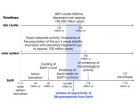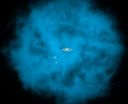(Press-News.org) Life in extreme environments – hot acids and heavy metals, for example – can apparently make very similar organisms deal with stress in very different ways, according to new research from North Carolina State University.
One single-celled organism from a hot spring near Mount Vesuvius in Italy fights uranium toxicity directly – by eating the heavy metal and acquiring energy from it. Another single-celled organism that lives on a "smoldering heap" near an abandoned uranium mine in Germany overcomes uranium toxicity indirectly – essentially shutting down its cellular processes to induce a type of cellular coma when toxic levels of uranium are present in its environment.
Interestingly, these very different responses to environmental stress come from two organisms that are 99.99 percent genetically identical.
In a paper published this week online in Proceedings of the National Academy of Sciences, NC State researchers show that these extreme organisms – basic life forms called Archaea that have no nucleus and that are so tiny they can only be seen under a microscope – can teach us a lot about how living things use different mechanisms to adapt to their surroundings.
The researchers, led by Dr. Robert Kelly, Alcoa Professor of Chemical and Biomolecular Engineering at NC State, exposed two very close relatives of thermoacidophilic Archaea – they live in highly acidic environments with temperatures of more than 70 degrees Celsius, or about 160 degrees Fahrenheit – to pure uranium. One, Metallosphaera sedula, metabolized the uranium as a way to support its energy needs.
That in itself was surprising to Kelly and his fellow researchers, as it was the first report that an organism can directly use uranium as an energy source.
"This could be a new way to mine uranium using microorganisms to release the metal from ores – a process referred to as bioleaching," Kelly says of M. sedula.
Its genetic twin, Metallosphaera prunae, reacted very differently. When faced with pure uranium, it went into a dormant state, shutting down critical cellular processes that enable it to grow. When the toxic threat was removed, M. prunae rebooted its cellular processes and returned to its normal state.
Kelly hypothesizes that M. prunae is an offshoot of M. sedula, with just a small number of mutations, or changes, to its genome that allow it to react differently when faced with heavy-metal toxicity.
Kelly says the findings could also have implications for understanding how antibiotic resistance develops and operates in pathogens.
"We have come across a new model for how organisms learn how to live in an environment that would otherwise be deadly for them," he says.
Kelly adds that the study calls into question the ways that scientists classified living things before the rise of the genomic era.
"How do we classify microorganisms now that we can compare genomes so easily?" Kelly asks. "These are not different species by the classical definition because their genomes are virtually identical, but they have very different phenotypes, or lifestyles, when faced with stress."
###
The research was funded by the Defense Threat Reduction Agency in the U.S. Department of Defense, and by the National Institutes of Health.
"Uranium extremophily is an adaptive, rather than intrinsic, feature for extremely thermoacidophilic Metallosphaera species"
Authors: Arpan Mukherjee, Garrett H. Wheaton and Robert M. Kelly, North Carolina State University; Paul H. Blum, University of Nebraska
Published: Online the week of Sept. 24, 2012, in Proceedings of the National Academy of Sciences
Abstract: Thermoacidophilic archaea are found in heavy metal-rich environments, and, in some cases, these microorganisms are causative agents of metal mobilization through cellular processes related to their bioenergetics. Given the nature of their habitats, these microorganisms must deal with the potentially toxic effect of heavy metals. Here, we show that two thermoacidophilic Metallosphaera species with nearly identical (99.99%) genomes differed signi?cantly in their sensitivity and reactivity to uranium (U).Metallosphaera prunae, isolated from a smoldering heap on a uranium mine in Thüringen, Germany, could be viewed as a "spontaneous mutant" of Metallosphaera sedula, an isolate from Pisciarelli Solfatara near Naples. Metallosphaera prunae tolerated triuranium octaoxide (U3O8) and soluble uranium
[U(VI)] to a much greater extent than M. sedula. Within 15 min following exposure to "U(VI) shock," M. sedula, and not M. prunae, exhibited transcriptomic features associated with severe stress response. Furthermore, within 15 min post-U(VI) shock, M. prunae, and not M. sedula, showed evidence of substantial degradation of cellular RNA, suggesting that transcriptional and translational processes were aborted as a dynamic mechanism for resisting U toxicity; by 60 min post-U(VI) shock, RNA integrity in M. prunae recovered, and known modes for heavy metal resistance were activated. In addition, M. sedula rapidly oxidized solid U3O8 to soluble U(VI) for bioenergetic purposes, a chemolithoautotrophic feature not previously reported. M. prunae, however, did not solubilize solid U3O8 to any signi?cant extent, thereby not exacerbating U(VI) toxicity. These results point to uranium extremophily as an adaptive, rather than intrinsic, feature for Metallosphaera species, driven by environmental factors.
END
Bladder cancer patients whose tumors express high levels of the protein CD24 have worse prognoses than patients with lower CD24. A University of Colorado Cancer Center study published today in the Proceedings of the National Academy of Sciences shows that CD24 expression may depend on androgens – and that anti-androgen therapies like those currently used to treat prostate cancer may benefit bladder cancer patients.
"This is a major finding – bladder cancer development and spread to other organs depends significantly on CD24, which in turn depends on androgens like testosterone. ...
Cold Spring Harbor, NY – A team of neuroscientists and chemists from the U.S. and China today publish research suggesting that a class of currently used anti-cancer drugs as well as several previously untested synthetic compounds show effectiveness in reversing memory loss in two animal models of Alzheimer's' disease.
CSHL Professor Yi Zhong, Ph.D., who led the research conducted in fruit flies and mice, says he and his colleagues were surprised with their results, which, he stressed, used two independent experimental approaches "the results of which clearly converged." ...
This press release is available in German and French.
In recent years, the demand for supposedly environmentally friendly biofuels has increased significantly worldwide; on the one hand, this has resulted in the increased cultivation of so-called energy plants and, on the other hand, innovative production methods for the second generation of biofuels have been developed. Parallel to this, ecobalance experts have refined and developed methods for environmental assessment. Since biofuels stem predominantly from agricultural products, the, in part, controversial discussion ...
JACKSONVILLE, Fla. — Men who undergo surgical removal of prostate cancer can experience significant levels of anxiety one year after surgery, and higher levels of anxiety appear to be linked to poor sexual satisfaction and depression, say researchers at Mayo Clinic's campus in Florida. Their recent study, published in the online edition of Psycho-Oncology, suggests that men who experience high levels of "cancer-specific anxiety" following surgery for prostate cancer could likely benefit from counseling designed to address their worries and improve their quality of life.
"The ...
TEMPE, Ariz. – The idea that drinking red wine may provide health benefits – or possibly even extend your life — is an appealing thought for many people. Now, there may be added attraction. Researchers have found that when given resveratrol, a compound found in red wine, bees consume less food.
Previous scientific studies on resveratrol show that it lengthens the lifespan of diverse organisms ranging from unicellular yeast, to fruit flies and mice. Since bees are social animals like humans, a team of scientists from Arizona State University, the Norwegian University ...
Berkeley — When it comes to germ-busting power, the eyes have it, according to a discovery by University of California, Berkeley, researchers that could lead to new, inexpensive antimicrobial drugs.
A team of UC Berkeley vision scientists has found that small fragments of keratin protein in the eye play a key role in warding off pathogens. The researchers also put synthetic versions of these keratin fragments to the test against an array of nasty pathogens. These synthetic molecules effectively zapped bacteria that can lead to flesh-eating disease and strep throat (Streptococcus ...
VIDEO:
The researchers explored the likelihood that our solar system exchanged solid matter with its closest planetary-system neighbor during the first hundreds of millions of years it existed. At that time,...
Click here for more information.
Microorganisms that crashed to Earth embedded in the fragments of distant planets might have been the sprouts of life on this one, according to new research from Princeton University, the University of Arizona and the Centro de Astrobiología ...
A novel genetic study led by the University of Colorado Boulder has helped to clarify the native diversity and distribution of cutthroat trout in Colorado, including the past and present haunts of the federally endangered greenback cutthroat trout.
The study, led by CU-Boulder postdoctoral researcher Jessica Metcalf, was based largely on DNA samples taken from cutthroat trout specimens preserved in ethanol in several U.S. museums around the country that were collected from around the state as far back as 150 years ago. The new study, in which Metcalf and her colleagues ...
CLEVELAND, Ohio (September 21, 2012)—Women treated for breast cancer after menopause with aromatase inhibitors have very high levels of sexual difficulties, including low interest, insufficient lubrication, and pain with intercourse. It is an important and underestimated problem, say the authors of a study published online in Menopause, the journal of the North American Menopause Society.
The researchers from Örebro University and Uppsala University in Sweden are the first to look at the impact of this type of breast cancer treatment on specific aspects of sexuality in ...
Astronomers have used NASA's Chandra X-ray Observatory to find evidence our Milky Way Galaxy is embedded in an enormous halo of hot gas that extends for hundreds of thousands of light years. The estimated mass of the halo is comparable to the mass of all the stars in the galaxy.
If the size and mass of this gas halo is confirmed, it also could be an explanation for what is known as the "missing baryon" problem for the galaxy.
Baryons are particles, such as protons and neutrons, that make up more than 99.9 percent of the mass of atoms found in the cosmos. Measurements ...



